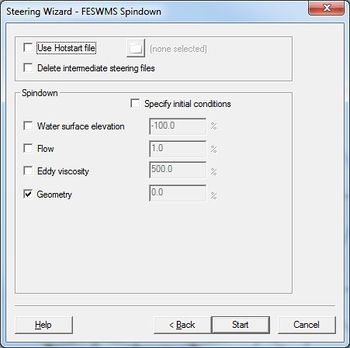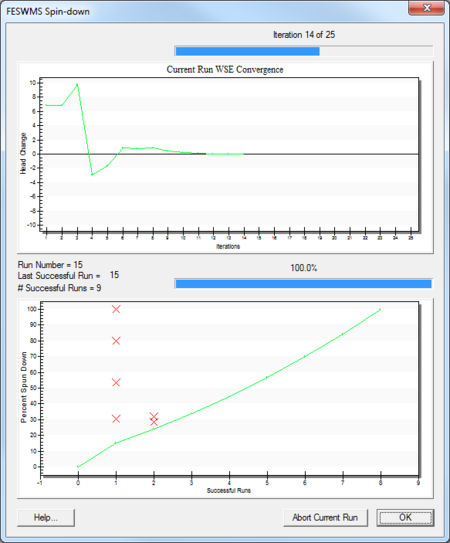SMS:FESWMS Spindown: Difference between revisions
m (→Related Topics) |
No edit summary |
||
| (26 intermediate revisions by the same user not shown) | |||
| Line 1: | Line 1: | ||
__NOINDEX__ | |||
{{SMS Deprecated Feature}} | |||
[[Image:SMS FESWMS Spindown.jpg|thumb|350 px|SMS ''Steering Wizard – FESWMS Spindown'' dialog]] | |||
For cold start simulations, the initial velocities are zero and the water surface elevation is constant. This is often referred to as the "bathtub condition." Often [[SMS:FESWMS|FESWMS]] will not directly converge using these initial conditions. | For cold start simulations, the initial velocities are zero and the water surface elevation is constant. This is often referred to as the "bathtub condition." Often [[SMS:FESWMS|FESWMS]] will not directly converge using these initial conditions. | ||
| Line 4: | Line 7: | ||
The flow equations are nonlinear and thus require an iterative solution, starting from some initial guessed value. Convergence of the iterative solution is not guaranteed. Since the desired boundary conditions may be vastly different from a cold start condition, it may be impossible to get convergence starting from this bathtub type condition. However, a solution can be obtained using a series of “Runs” that generate solutions progressively closer to the desired answer. Intermediate boundary conditions that are closer to the final desired boundary conditions are specified to generate a set of flow conditions. These conditions do not represent the final desired flow conditions, but are closer to the final desired flow conditions than the original cold start, and can be used as initial conditions for a subsequent run. Starting the model from a previous solution is called “Hot Starting”. In the incremental loading strategy, “loads” consisting of applied flow rates and water surface elevations along the boundary increment from a cold start condition to the final condition. By choosing a suitably small increment in the boundary conditions, convergence can be attained. | The flow equations are nonlinear and thus require an iterative solution, starting from some initial guessed value. Convergence of the iterative solution is not guaranteed. Since the desired boundary conditions may be vastly different from a cold start condition, it may be impossible to get convergence starting from this bathtub type condition. However, a solution can be obtained using a series of “Runs” that generate solutions progressively closer to the desired answer. Intermediate boundary conditions that are closer to the final desired boundary conditions are specified to generate a set of flow conditions. These conditions do not represent the final desired flow conditions, but are closer to the final desired flow conditions than the original cold start, and can be used as initial conditions for a subsequent run. Starting the model from a previous solution is called “Hot Starting”. In the incremental loading strategy, “loads” consisting of applied flow rates and water surface elevations along the boundary increment from a cold start condition to the final condition. By choosing a suitably small increment in the boundary conditions, convergence can be attained. | ||
[[SMS:FESWMS|FESWMS]] | [[SMS:FESWMS|FESWMS]] spindown refers to the process of using the [[SMS:Steering|Steering module]] to automate the process of incremental loading. The [[SMS:Steering|Steering module]] can vary the following: | ||
* Boundary Conditions | * ''Boundary Conditions'' | ||
** Water surface elevation | ** ''Water surface elevation'' | ||
** Flow rate | ** ''Flow rate'' | ||
* Model Parameters | * ''Model Parameters'' | ||
** Eddy viscosity | ** ''Eddy viscosity'' | ||
* Finite Element Network | * ''Finite Element Network'' | ||
** Geometry (nodal elevations) | ** ''Geometry (nodal elevations)'' | ||
This replaces the need to perform incremental loading by hand in [[SMS:FESWMS|FESWMS]]. | This replaces the need to perform incremental loading by hand in [[SMS:FESWMS|FESWMS]]. | ||
==FESWMS Spindown Dialog== | |||
[[File:FESWMS Spin-down.png|thumb|450 px|The ''FESWMS Spindown'' dialog]] | |||
The ''FESWMS Spindown'' dialog updates with the progress of spinning down the model. | |||
The top window explains the spindown convergence of the current run. Each iteration shows as a green point, allowing determination of if the run is converging or diverging (moving toward or away from 0 head change). The iteration being performed is shown just above this plot. | |||
The bottom window shows the overall spindown of the model. The green points represent successful runs, and the red Xs represent failed runs. When this plot reaches 100% spun down, the model is finished. This percent is shown just above this plot. | |||
This process can take several minutes to complete. When the spindown has finished, a window appears advising that the "Steering process has terminated – See status file for details." This status file is named "SteeringStatus.txt" and gives a summary of the steering process. A final solution file will also be created. | |||
== Related Topics == | == Related Topics == | ||
| Line 23: | Line 36: | ||
* [[SMS:Steering|Steering]] | * [[SMS:Steering|Steering]] | ||
{{Template:Navbox SMS}} | |||
[[Category:FESWMS|Spindown]] | |||
[[Category:FESWMS Dialogs|spin]] | |||
[[Category:Steering]] | |||
[[Category:Archived]] | |||
Latest revision as of 22:36, 26 June 2019
| This contains information about features no longer in use for the current release of SMS. The content may not apply to current versions. |
For cold start simulations, the initial velocities are zero and the water surface elevation is constant. This is often referred to as the "bathtub condition." Often FESWMS will not directly converge using these initial conditions.
Incremental Loading Strategy
The flow equations are nonlinear and thus require an iterative solution, starting from some initial guessed value. Convergence of the iterative solution is not guaranteed. Since the desired boundary conditions may be vastly different from a cold start condition, it may be impossible to get convergence starting from this bathtub type condition. However, a solution can be obtained using a series of “Runs” that generate solutions progressively closer to the desired answer. Intermediate boundary conditions that are closer to the final desired boundary conditions are specified to generate a set of flow conditions. These conditions do not represent the final desired flow conditions, but are closer to the final desired flow conditions than the original cold start, and can be used as initial conditions for a subsequent run. Starting the model from a previous solution is called “Hot Starting”. In the incremental loading strategy, “loads” consisting of applied flow rates and water surface elevations along the boundary increment from a cold start condition to the final condition. By choosing a suitably small increment in the boundary conditions, convergence can be attained.
FESWMS spindown refers to the process of using the Steering module to automate the process of incremental loading. The Steering module can vary the following:
- Boundary Conditions
- Water surface elevation
- Flow rate
- Model Parameters
- Eddy viscosity
- Finite Element Network
- Geometry (nodal elevations)
This replaces the need to perform incremental loading by hand in FESWMS.
FESWMS Spindown Dialog
The FESWMS Spindown dialog updates with the progress of spinning down the model.
The top window explains the spindown convergence of the current run. Each iteration shows as a green point, allowing determination of if the run is converging or diverging (moving toward or away from 0 head change). The iteration being performed is shown just above this plot.
The bottom window shows the overall spindown of the model. The green points represent successful runs, and the red Xs represent failed runs. When this plot reaches 100% spun down, the model is finished. This percent is shown just above this plot.
This process can take several minutes to complete. When the spindown has finished, a window appears advising that the "Steering process has terminated – See status file for details." This status file is named "SteeringStatus.txt" and gives a summary of the steering process. A final solution file will also be created.
Related Topics
- FESWMS
- FESWMS Files
- FESWMS Graphical Interface
- FESWMS Hydraulic Structures
- FESWMS Model Control Dialog
- Steering
SMS – Surface-water Modeling System | ||
|---|---|---|
| Modules: | 1D Grid • Cartesian Grid • Curvilinear Grid • GIS • Map • Mesh • Particle • Quadtree • Raster • Scatter • UGrid |  |
| General Models: | 3D Structure • FVCOM • Generic • PTM | |
| Coastal Models: | ADCIRC • BOUSS-2D • CGWAVE • CMS-Flow • CMS-Wave • GenCade • STWAVE • WAM | |
| Riverine/Estuarine Models: | AdH • HEC-RAS • HYDRO AS-2D • RMA2 • RMA4 • SRH-2D • TUFLOW • TUFLOW FV | |
| Aquaveo • SMS Tutorials • SMS Workflows | ||

